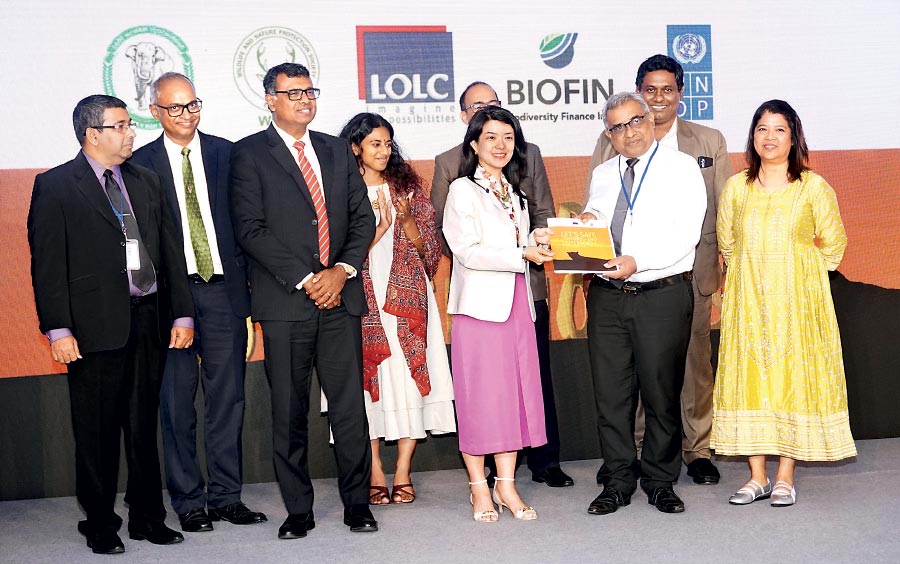Friday Dec 05, 2025
Friday Dec 05, 2025
Thursday, 21 August 2025 05:16 - - {{hitsCtrl.values.hits}}

From left: WNPS Project Lead Spencer Manuelpillai, LOLC Insurance COO Kithsiri Gunawardena, UNDP Sri Lanka Resident Representative Azusa Kubota and DWC Director General Ranjan Marasinghe
By Randima Attygalle
The United Nations Development Programme (UNDP) on Tuesday launched Sri Lanka’s first Livestock Insurance Scheme in collaboration with the Wildlife and Nature Protection Society (WNPS) and LOLC Insurance, under the guidance of the Department of Wildlife Conservation (DWC), to compensate farmers for animals lost to leopard attacks and reduce retaliatory killings of the endangered species.
UNDP Sri Lanka Resident Representative Azusa Kubota said the initiative was “not merely an isolated act of conservation, but a collective commitment to preserving the beauty, bio-diversity and the economic opportunity nature provides for all of us.” Kubota went on to remark that saving the endangered Lankan Leopard, the apex predator of the island’s terrestrial ecosystems, was also a means of acknowledging its role as an “economic driver” in the tourism industry.
Remarking that Sri Lanka was not alone in the rising human-wildlife conflict and drawing examples from several regional counterparts, Kubota acknowledged the challenges insurance schemes entail.
Applauding the ‘quick compensation’ feature of the newly launched scheme as a ‘trust-building factor’ among the communities, Kubota pledged the UNDP’s continuous support for a proactive initiative that would practically work for people.
With the country’s depleting forest cover, our very own iconic leopard’s (Panthera pardus kotiya) future is bleak, driving it to human-dominated areas where it comes to conflict with communities, occasionally preying on livestock. This results in significant economic losses for rural farmers, triggering retaliatory killings, further endangering the species.
In 2022, the WNPS initiated the Multi-Regional Leopard Research and Conservation Project in partnership with LOLC Holdings, establishing six research centres across Panama, Sigiriya, Kilinochchi, Belihuloya, Kalawana, and Kotagala. Baseline surveys in the Sigiriya research area revealed frequent livestock predation in villages bordering protected areas and buffer zones. Many of these incidents resulted in unreported retaliatory killings, including poisoning, snaring, and shooting.
The Livestock Insurance Scheme was developed in direct response to these findings. It aims to provide timely and fair financial support to affected farmers, reducing the economic impact of livestock loss while promoting goodwill towards leopard conservation. It also seeks to strengthen trust between conservation authorities and communities, improve data collection on predation incidents, and inform proactive conflict prevention measures.
Noting that over the years, leopard conservation in the country had faced numerous challenges, DWC Director General Ranjan Marasinghe noted that the new scheme offers a practical and timely solution by ensuring that affected farmers are compensated swiftly and fairly by addressing the root cause of the human-leopard conflict. A win-win tool which conserves the magnificent creature and safeguards rural livelihoods, the insurance scheme is also a ‘trust-building’ mechanism between communities and conservation authorities, he said.
“We are ensuring the farmers that their voices are heard, their losses are compensated, and that their welfare matters,” he said.
Calling all partners to strengthen the newly launched insurance scheme as a sustainable and viable effort which can expand to all areas where the human-leopard conflict is prevalent, LOLC Insurance Chief Operating Officer Kithsiri Gunawardena said: “This pioneering initiative not only addresses an urgent conservation need, but also reflects our long-term commitment to safeguarding biodiversity while supporting rural livelihoods.”
Applauding the efforts of the UNDP, DWC and WNPS, he further noted that his organisation is proud to be partnering with them and that such a partnership sets good precedent to further collaborations that could create sustainable solutions where both communities and wildlife can thrive.
UNDP Sri Lanka, through BIOFIN, will cover the cost of the insurance premium, with LOLC Insurance acting as the scheme’s insurance provider. In the event of livestock loss due to leopard predation, affected farmers can report the incident to a designated WNPS Regional Officer. The DWC, together with veterinary and Grama Niladhari officers, will then conduct a prompt verification and assessment. Once eligibility is confirmed, claims are processed without delay, and compensation is transferred directly to the farmer, typically within 72 hours of verification.
WNPS President Graham Marshall noted that the foundation of this ambitious scheme is the understanding of the fact that leopard-killing is a direct result of the infringement of the rights of the rural communities. “Their economic security is at stake and addressing this root cause is fundamental to the success of any conservation activity,” said Marshall, who applauded the compensation scheme as one built on practical realities, science, as well as trust.
Endorsing the insurance scheme as “a strong and practical first step providing immediate relief to affected farmers,” WNPS Project Lead Spencer Manuelpillai called for several more multiple efforts in addressing the longstanding challenge in leopard conservation while supporting the communities.
He also cited the innovative preventative measures the program strives to champion, beyond providing immediate relief. Among them are predator-proof night-time enclosures, communal livestock pens for shared overnight housing, the eye-cow technique (where artificial eye spots painted on the hindquarters of cattle deter ambush predators from attacking cattle), and an innovative ‘Cattle Bank’ system, offering replacement animals instead of monetary payouts. These initiatives, as Manuelpillai noted, aim to reduce livestock losses, prevent ‘revenge killings,’ and foster coexistence between people and leopards.
- Pic by Lasantha Kumara